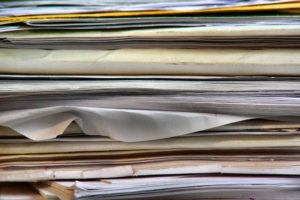We still receive a lot of paper. People hand us receipts and flyers. We get bills and statements in the mail.
I don’t keep all of these, of course, but all my life, I dutifully kept mortgage statements, credit card statements, any unusual financial notices, etc. I’ve gone paperless with as many bills as I can, but some places are still old-school. I told myself I’d sort through them all. I honestly thought I would.
And sure, enough, once in my life I went through and tossed a bunch of old credit card statements. The rest of the time, they piled up in my two filing cabinets.
As I began to pursue minimalism, I realized I didn’t need physical copies of almost any of these documents. I could just scan them in.
At first I thought I’d just need to spend a couple of days with a scanner and digitize everything, so I only needed to find or borrow a scanner briefly. But after a few days of planning, I thought about the future. What would I do with the next piece of paper that arrived in the mail?
So I looked around and invested in a USD $75 “mobile” scanner, meaning instead of a flat scanner bed it feeds documents through rollers. These used to be finicky and low-quality, but it turns out they’ve gotten a lot more reliable in recent years. They’re also compact, so I don’t have to haul out a flat bed scanner every time I want to scan something.
Oh man, this has worked beautifully. I can pull out the scanner, plug it in, fire up the software, and scan a 2-page document in about 60 seconds. At which point, I never have to handle that piece of paper again.
Now, you might say, what’s the difference between putting a physical piece of paper in a filing cabinet instead of dragging a digital file into a folder? Well, that paper takes up physical space. After enough time, I’ll fill up that filing cabinet, or I’ll have to spend a lot of time purging.
In contrast, a 2-page scanned document on my hard drive takes up 30 KB; I can just leave it there forever. And if I ever have to make a serious purge, that’s actually faster with digital files (I can drag and drop 50 files a lot faster digitally than physically).
But that’s not all. I’ve moved three times in my life, and I’ll likely move again. That’s just the odds in our increasingly mobile world, where it’s downright easy to get a better job in another state (or even another country), compared to just fifty years ago. When I have to move, I’ll have to bring all that paper with me, or attempt a purge just when I have less time to do it.
Now, I’m not anti-paper. I believe it takes less time to stick papers in a filing cabinet that uses alphabetically-labeled folders than to scan them, and paper is great for certain kinds of work.
But I now also believe that the saved time of storing paper comes with hidden costs, in stuff that needs to be physically managed in a way that digital files don’t. Even if paper is filed away, the container in which it’s filed is taking up space and needs to be cleaned and maintained (and pulled out to get at that pen that fell behind it).
In any event, this scanner has been a powerful investment. As of my writing this, I’ve processed (that is, reviewed and either scanned-and-shredded or trashed) about 3/4 of the papers in my house: a three-drawer filing cabinet and a banker’s box, all now empty. I intend to get to the point where I only keep a banker’s box worth of critical paperwork (like the deed to my truck), and every page that comes in gets either scanned or recycled on the day I receive it. It only takes a few minutes; slightly more time than it took me before to file it. And I won’t have to haul it around ever again.
